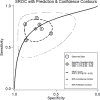Sequential organ failure assessment in predicting mortality after paraquat poisoning: A meta-analysis
- PMID: 30444919
- PMCID: PMC6239328
- DOI: 10.1371/journal.pone.0207725
Sequential organ failure assessment in predicting mortality after paraquat poisoning: A meta-analysis
Abstract
Sequential organ failure assessment (SOFA) score is commonly used to determine disease severity and predict prognosis in critically ill patients. However, the prognostic value of SOFA after acute paraquat (PQ) poisoning remains unclear. This meta-analysis aimed to study the capability of SOFA to predict mortality in patients with PQ poisoning. Databases that included PubMed, Embase, Web of Science, ScienceDirect, Embase, and Cochrane Library were searched through May 2018. Six studies involving 946 patients were included in the meta-analysis. Study-specific odds ratios (ORs) and 95% confidence intervals (CIs) were calculated, and then ORs with 95% CIs were pooled for the estimation of the prognostic role of SOFA in patients with PQ poisoning. Results showed that higher SOFA in patients with PQ poisoning was related to severe mortality (OR = 8.14, 95%CI 4.26-15.58, p<0.001). The pooled sensitivity, specificity, positive likelihood ratio, negative likelihood ratio, diagnostic OR, and area under the curve were 72% (95%CI 0.65-0.79), 75% (95%CI 0.65-0.83), 2.9 (95%CI 2.0-4.1), 0.37 (95%CI 0.28-0.41), 8 (95%CI 4-14), and 0.79 (95%CI 0.76-0.83), respectively. No evidence of publication bias was detected by funnel plot analysis and formal statistical tests. Sensitivity analyses showed no important differences in the estimates of effects. The high SOFA score (8.1-fold) was associated with severe mortality in patients with PQ poisoning.
Conflict of interest statement
The authors have declared no competing interests exist.
Figures






Similar articles
-
Comparison of severity index and plasma paraquat concentration for predicting survival after paraquat poisoning: A meta-analysis.Medicine (Baltimore). 2020 Feb;99(6):e19063. doi: 10.1097/MD.0000000000019063. Medicine (Baltimore). 2020. PMID: 32028427 Free PMC article.
-
Arterial lactate in predicting mortality after paraquat poisoning: A meta-analysis.Medicine (Baltimore). 2018 Aug;97(34):e11751. doi: 10.1097/MD.0000000000011751. Medicine (Baltimore). 2018. PMID: 30142762 Free PMC article. Review.
-
Base excess in predicting the prognosis of patients with paraquat poisoning: A meta-analysis.Medicine (Baltimore). 2019 Jun;98(23):e15973. doi: 10.1097/MD.0000000000015973. Medicine (Baltimore). 2019. PMID: 31169729 Free PMC article.
-
Pneumomediastinum predicts early mortality in acute paraquat poisoning.Clin Toxicol (Phila). 2015 Jul;53(6):551-6. doi: 10.3109/15563650.2015.1046183. Epub 2015 Jun 13. Clin Toxicol (Phila). 2015. PMID: 26072933
-
[Early white blood cell count in predicting mortality after acute paraquat poisoning: a Meta-analysis].Zhonghua Wei Zhong Bing Ji Jiu Yi Xue. 2019 Aug;31(8):1013-1017. doi: 10.3760/cma.j.issn.2095-4352.2019.08.020. Zhonghua Wei Zhong Bing Ji Jiu Yi Xue. 2019. PMID: 31537230 Chinese.
Cited by
-
Comparing Sequential Organ Failure Assessment Score, Acute Physiology and Chronic Health Evaluation II, Modified Acute Physiology and Chronic Health Evaluation II, Simplified Acute Physiology Score II and Poisoning Severity Score for Outcome Prediction of Pesticide Poisoned Patients Admitted to the Intensive Care Unit.J Res Pharm Pract. 2024 Jan 31;12(2):49-57. doi: 10.4103/jrpp.jrpp_43_23. eCollection 2023 Apr-Jun. J Res Pharm Pract. 2024. PMID: 38463184 Free PMC article.
-
A comparison of different scores for mortality prediction of acutely poisoned patients: a systematic review and meta-analysis.Toxicol Res (Camb). 2025 Jun 21;14(3):tfaf080. doi: 10.1093/toxres/tfaf080. eCollection 2025 Jun. Toxicol Res (Camb). 2025. PMID: 40585421
-
Hyperamylasemia as an early predictor of mortality in patients with acute paraquat poisoning.J Int Med Res. 2020 Mar;48(3):300060520910037. doi: 10.1177/0300060520910037. J Int Med Res. 2020. PMID: 32223576 Free PMC article.
-
Prognostic Value of the Average Lung CT Number in Patients with Acute Paraquat Poisoning.Emerg Med Int. 2023 Sep 12;2023:4443680. doi: 10.1155/2023/4443680. eCollection 2023. Emerg Med Int. 2023. PMID: 37731548 Free PMC article.
-
Platelet-lymphocyte ratio is not a prognostic predictor for acute paraquat-intoxicated patients: A retrospective analysis.Medicine (Baltimore). 2019 May;98(20):e15702. doi: 10.1097/MD.0000000000015702. Medicine (Baltimore). 2019. PMID: 31096516 Free PMC article.
References
-
- Gil HW, Hong JR, Jang SH, Hong SY. Diagnostic and therapeutic approach for acute paraquat intoxication. J Korean Med Sci. 2014;29(11):1441–9. 10.3346/jkms.2014.29.11.1441 . - DOI - PMC - PubMed
-
- Wu WP, Lai MN, Lin CH, Li YF, Lin CY, Wu MJ. Addition of immunosuppressive treatment to hemoperfusion is associated with improved survival after paraquat poisoning: a nationwide study. PLoS One. 2014;9(1):e87568 10.1371/journal.pone.0087568 . - DOI - PMC - PubMed
-
- Zhang YJ, Yu BX, Wang NN, Li TG. Acute poisoning in Shenyang, China: a retrospective and descriptive study from 2012 to 2016. BMJ Open. 2018;8(8):e021881 10.1136/bmjopen-2018-021881 . - DOI - PMC - PubMed
-
- Gao J, Feng S, Wang J, Yang S, Li Y. Prolonged methylprednisolone therapy after the pulse treatment for patients with moderate-to-severe paraquat poisoning: A retrospective analysis. Medicine (Baltimore). 2017;96(25):e7244 10.1097/MD.0000000000007244 . - DOI - PMC - PubMed
-
- Tan JT, Letchuman Ramanathan G, Choy MP, Leela R, Lim BK. Paraquat poisoning: experience in hospital taiping (year 2008—october 2011). Med J Malaysia. 2013;68(5):384–8. . - PubMed
Publication types
MeSH terms
Substances
LinkOut - more resources
Full Text Sources

